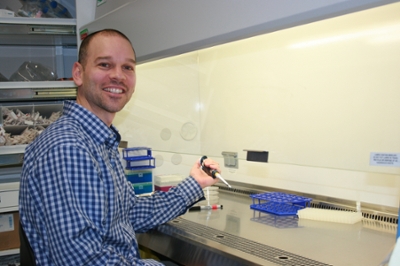
Shedding light on copper’s life-and-death balancing act
University of Saskatchewan researcher Scot Leary has begun to shed light on a little-understood process critical to life
University of Saskatchewan researcher Scot Leary has begun to shed light on a little-understood process critical to life—how cells regulate copper.
“You have about 30 proteins in the cell that require copper as a structural or catalytic factor,” said Leary, a biochemist in the College of Medicine, adding copper dysregulation is at the root of a multitude of illnesses, from Lou Gehrig’s disease and dementia. The body’s cells also use copper to fight off infections.
“Perturbations in copper handling – be it acquisition, distribution or excretion—cause severe, fatal forms of human disease,” Leary said, explaining that there are intricate mechanisms to move copper around the body. “However, we know shockingly little about these mechanisms.”
Leary and his team have shed a little light on copper’s mysteries with their discovery that mitochondria, the power plants inside all living cells, help to perfectly balance levels of the essential element – a state called homeostasis – to keep the cell healthy.
Specifically, they looked at the gene Sco1, whose proper functioning is essential to copper homeostasis. They found a novel connection between the gene and a molecule called CTR1, which is responsible for importing copper into the cell. When they disrupted the gene in a mouse model, it caused a severe copper deficiency, and cells couldn’t make the proteins they needed to make energy— a lethal condition. Their work is published in the journal Cell Reports.
According to Leary, copper is a Swiss Army knife of elements when it comes to the body’s chemistry, beginning in the womb where it’s critical to central nervous system development, to the end of life, where its proper function is essential to cognition and retaining memory.
Rare genetic flaws involving copper metabolism cause Menkes disease, whose deficient victims rarely live to see their 10th birthday, and Wilson disease, whose surfeit of copper can be treated. More common is amyotrophic lateral sclerosis, better known as ALS or Lou Gehrig’s disease, caused by dysfunction in an essential copper-related protein. Leary explained copper is also part of the immune system’s arsenal, used in the “oxidative burst” – a blast of reactive molecules that cells unleash to attack invading bacteria, viruses or fungi.
“Copper is turning out to be really big at the host-pathogen interface,” he said. “Pathogens are more virulent if they’re able to kick copper out that the host throws at them. We don’t really understand the interplay between host and pathogen in this context and how that may be manipulated in our favour.”
Leary said there is also a growing body of evidence that dysfunctional copper regulation is involved in some types of dementia in older adults.
“Copper is turning out to be important to brain physiology and there is clear and exciting evidence that late-onset, cognitive disorders with neurodegeneration involve dysregulation of copper homeostasis.”
Article courtesy of OCN, photo by Michael Robin
